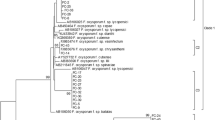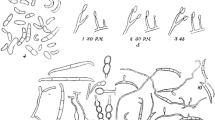Abstract
Twenty-eight isolates of Fusarium oxysporum f. sp. spinaciae (FOS; the causal agent of spinach wilt) collected from Japan were assessed for mating type and subjected to phylogenetic analysis. Mating type analysis revealed all isolates to be MAT1-2, suggesting that there is no sexual recombination within the population. Phylogenetic analyses based on nucleotide sequences of the ribosomal DNA intergenic spacer (IGS) and the mating type locus (MAT1) suggested that FOS is polyphyletic. The cluster analysis based on IGS showed four phylogenetic groups (S1–S4) among the isolates. Two distinct lineages, S1 and S3, included FOS isolates both of the vegetative compatibility group (VCG) types, 0330 and 0331, demonstrating that VCG differentiation in FOS may not necessarily reflect the phylogenetic relationships based on IGS and MAT1-2-1.


Similar content being viewed by others
References
Appel DJ, Gordon TR (1996) Relationships among pathogenic and nonpathogenic isolates of Fusarium oxysporum based on the partial sequence of the intergenic spacer region of the ribosomal DNA. Mol Plant Microbe Interact 9:125–138
Arie T, Christiansen SK, Yoder OC, Turgeon BG (1997) Efficient cloning of ascomycete mating type genes by PCR amplification of the conserved MAT HMG box. Fungal Genet Biol 21:118–130
Arie T, Yoshida T, Shimizu T, Kawabe M, Yoneyama K, Yamaguchi I (1999) Assessment of Gibberella fujikuroi mating type by PCR. Mycoscience 40:311–314
Arie T, Kaneko I, Yoshida T, Noguchi M, Nomura Y, Yamaguchi I (2000) Mating-type genes from asexual phytopathogenic ascomycetes Fusarium oxysporum and Alternaria alternata. Mol Plant Microbe Interact 13:1330–1339
Armstrong GM, Armstrong JK (1976) Common hosts for Fusarium oxysporum formae speciales spinaciae and betae. Phytopathology 66:542–545
Barve MP, Arie T, Salimath SS, Muehlbauer FJ, Peever TL (2003) Cloning and characterization of mating type (MAT) locus from Ascochyta rabiei (teleomorph: Didymella rabiei) and a MAT phylogeny of legume-associated Ascochyta spp. Fungal Genet Biol 39:151–167
Bentley S, Pegg KG, Moore NY, Davis RD, Buddenhagen IW (1998) Genetic variation among vegetative compatibility groups of Fusarium oxysporum f. sp. cubense analyzed by DNA fingerprinting. Phytopathology 88:1283–1293
Booth C (1971) The genus Fusarium. Commonwealth Mycological Institute, Kew, Surrey
Elias KS, Zamir D, Lichtman-Pleban T, Katan T (1993) Population structure of Fusarium oxysporum f. sp. lycopersici: restriction fragment length polymorphisms provide genetic evidence that vegetative compatibility group is an indicator of evolutionary origin. Mol Plant Microbe Interact 6:565–572
Felsenstein J (1981) Evolutionary trees from DNA sequences: a maximum likelihood approach. J Mol Evol 17:368–376
Felsenstein J (2004) PHYLIP (Phylogeny Inference Package) version 3.6. Distributed by the author. Department of Genome Sciences, University of Washington, Seattle
Fernandez D, Assigbetse K, Dubois MP, Geiger JP (1994) Molecular characterization of races and vegetative compatibility groups in Fusarium oxysporum f. sp. vasinfectum. Appl Environ Microbiol 60:4039–4046
Fiely MB, Correll JC, Morelock TE (1995) Vegetative compatibility, pathogenicity, and virulence diversity of Fusarium oxysporum recovered from spinach. Plant Dis 79:990–993
Fitch WM (1977) On the problem of discovering the most parsimonious tree. Am Nat 111:223–257
Fujinaga M, Ogiso H, Shinohara H, Tsushima S, Nishimura N, Togawa M, Saito H, Nozue M (2005) Phylogenetic relationships between the lettuce root rot pathogen Fusarium oxysporum f. sp. lactucae race 1, 2, and 3 based on the sequence of the intergenic spacer region of its ribosomal DNA. J Gen Plant Pathol 71:402–407
Katan T (1999) Current status of vegetative compatibility groups in Fusarium oxysporum. Phytoparasitica 27:51–64
Katan T, Di Primo P (1999) Current status of vegetative compatibility groups in Fusarium oxysporum: Supplement (1999). Phytoparasitica 27:273–277
Katsube K (1999) Geographic distribution and structure of a field population of Japanese isolates of Fusarium oxysporum f. sp. spinaciae based on vegetative compatibility in Japan. Ann Phytopathol Soc Jpn 65:563–568 (in Japanese with English abstract)
Katsube K (2001) Studies on Fusarium wilt of spinach, caused by Fusarium oxysporum f. sp. spinaciae. Res Bull Iwate Agric Res Cent 2:1–60 (in Japanese)
Katsube K, Akasaka Y (1997) Control of Fusarium wilt of spinach by transplanting seedlings pretreated with non-pathogenic Fusarium oxysporum. Ann Phytopathol Soc Jpn 63:389–394 (in Japanese with English abstract)
Kawabe M, Kobayashi Y, Okada G, Yamaguchi I, Teraoka T, Arie T (2005) Three evolutionary lineages of tomato wilt pathogen, Fusarium oxysporum f. sp. lycopersici, based on sequences of IGS, MAT1, and pg1, are each composed of isolates of a single mating type and a single or closely related vegetative compatibility group. J Gen Plant Pathol 71:263–272
Kimura M (1980) A simple method for estimating evolutionary rates of base substitutions through comparative studies of nucleotide sequences. J Mol Evol 16:111–120
Kistler HC (1997) Genetic diversity in the plant-pathogenic fungus Fusarium oxysporum. Phytopathology 87:474–479
Koenig RL, Ploetz RC, Kistler HC (1997) Fusarium oxysporum f. sp. cubense consists of a small number of divergent and globally distributed clonal lineages. Phytopathology 87:915–923
Kumar S, Tamura K, Jakobsen IB, Nei M (2001) MEGA2: molecular evolutionary genetics analysis software. Bioinformatics 17:1244–1245
Leslie JF (1993) Fungal vegetative compatibility. Annu Rev Phytopathol 31:127–150
Lori G, Edel-Hermann V, Gautheron N, Alabouvette C (2004) Genetic diversity of pathogenic and nonpathogenic populations of Fusarium oxysporum isolated from carnation fields in Argentina. Phytopathology 94:661–668
Manicom BQ, Baayen RP (1993) Restriction fragment length polymorphisms in Fusarium oxysporum f. sp. dianthi and other fusaria from Dianthus species. Plant Pathol 42:851–857
Mes JJ, Van Doorn J, Roebroeck EJA, Van Egmond E, Van Aartrijk J, Boonekamp PM (1994) Restriction fragment length polymorphisms, races and vegetative compatibility groups within a worldwide collection of Fusarium oxysporum f. sp. gladioli. Plant Pathol 43:362–370
O’Donnell K, Kistler HC, Cigelnik E, Ploetz RC (1998) Multiple evolutionary origins of the fungus causing Panama disease of banana: Concordant evidence from nuclear and mitochondrial gene genealogies. Proc Natl Acad Sci USA 95:2044–2049
Pöggeler S (1999) Phylogenetic relationships between mating-type sequences from homothallic and heterothallic ascomycetes. Curr Genet 36:222–231
Saitou N, Nei M (1987) The neighbor-joining method: a new method for reconstructing Phylogenetic trees. Mol Biol Evol 4:406–425
Shimazu J, Yamauchi N, Hibi T, Satou M, Horiuchi S, Shirakawa T (2005) Development of sequence tagged site markers to identify races of Fusarium oxysporum f. sp. lactucae. J Gen Plant Pathol 71:183–189
Thompson JD, Gibson TJ, Plewniak F, Jeanmougin F, Higgins DG (1997) The ClustalX windows interface: flexible strategies for multiple sequence alignment aided by quality analysis tools. Nucleic Acids Res 25:4876–4882
Turgeon BG (1998) Application of matign type gene technology to problems in fungal biology. Annu Rev Phytopathol 36:115–137
Vakalounakis DJ, Fragkiadakis GA (1999) Genetic diversity of Fusarium oxysporum isolates from cucumber: differentiation by pathogenicity, vegetative compatibility, and RAPD fingerprinting. Phytopathology 89:161–168
Vakalounakis DJ, Wang Z, Fragkiadakis GA, Skaracis GN, Li DB (2004) Characterization of Fusarium oxysporum isolates obtained from cucumber in China by pathogenicity, VCG, and RAPD. Plant Dis 88:645–649
Woudt LP, Neuvel A, Sikkema A, Van Grinsven MQJM, De Milliano WAJ, Campbell CL, Leslie JF (1995) Genetic variation in Fusarium oxysporum from cyclamen. Phytopathology 85:1348–1355
Acknowledgments
We are grateful to Dr M. Chilvers and Ms. J.E. Stewart for proofreading and suggestion. This study was partly supported by a Grant-in-aid from Japan Society for the Promotion of Science (JSPS) to TA.
Author information
Authors and Affiliations
Corresponding author
Rights and permissions
About this article
Cite this article
Kawabe, M., Katsube, K., Yoshida, T. et al. Genetic diversity of Fusarium oxysporum f. sp. spinaciae in Japan based on phylogenetic analyses of rDNA-IGS and MAT1 sequences. J Gen Plant Pathol 73, 353–359 (2007). https://doi.org/10.1007/s10327-007-0036-6
Received:
Accepted:
Published:
Issue Date:
DOI: https://doi.org/10.1007/s10327-007-0036-6




